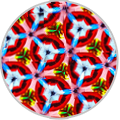Cytognos

Flow Cytometry is a powerful tool for the analytical and quantitative characterization of cells which provides rapid, quantitative and multiparametric analysis of heterogeneous cell populations on a cell-by-cell basis. Flow cytometry is performed on cells in liquid suspension that have been incubated with fluorescently-labeled antibodies directed against specific cellular proteins. The relative fluorescence intensity of the positive cells indicates the amount of antibody bound to specific binding sites on the cells, and therefore provides a relative measure of antigen expression.
Human lymphocytes may be classified in three main populations according to their biological function and their cell surface antigenexpression: T lymphocytes, B lymphocytes and natural killer cells (NK). T lymphocytes (CD3+), the precursors of which originate in the bone marrow and then migrate and mature in the thymus, can be subdivided as well in functionally different populations. The most clearly defined of these are helper/inducer T cells(CD3+CD4+) and suppressor/cytotoxic T cells(CD3+CD8+). T cells produce no antibodies and are the mediators of cell immunity.
Lymphogram™
Lymphogram™ kit is a 3-color mixture of monoclonal antibodies with carefully selected fluorescence intensities designed to simultaneously determine in peripheral blood, bone marrow and other body fluids the major lymphocyte subpopulations, including total T-cells (CD3+), B-cells (CD19+) and NK-cells (CD3- CD56+) as well as helper/inducer (CD3+ CD4+) and suppressor/cytotoxic (CD3+ CD8+) T-cell subsets.
Lymphoclonal™
Lymphoclonal™ kit is a 4-color antibody mixture aimed to study lymphocyte subsets and determine clonality of B-cells in peripheral blood, bone marrow and other body fluids.
Lymphoclonal™ is a rapid, effective and reliable tool for initial screening of lymphocyte subsets which permits the identification of total T-cells (CD3+), B-cells (CD19+) and NK-cells (CD3- CD56+) as well as helper/inducer (CD3+ CD4+) and suppressor/cytotoxic (CD3+ CD8+) T-cell subsets, and B-cell subsets with light chain immunophenotype kappa (CD19+ SmIgκ+) and lambda (CD19+ SmIgλ+).
Lymphoclonal™-9
Lymphoclonal™-9 is a 6-color reagent designed to simultaneously determine in peripheral blood, bone marrow and other body fluids the major lymphocyte subpopulations: T-cells (CD3+), B-cells (CD19+ CD20+) and NK-cells (CD3- CD56+) as well as helper/inducer (CD3+ CD4+) and suppressor/cytotoxic (CD3+ CD8+) T-cell subsets, and B-cell subsets with light chain immunophenotype kappa (CD19+ SmIgκ+) and lambda (CD19+ SmIgλ+).
This 6-color panel can be used for initial evaluation of several suspected clinical conditions such as lymphocytosis, lymph node enlargement, unexplained cytopenias, etc.
Plasma cell studies: Clonalpath™ and Clonalpath™–Plus
Clonalpath™ and Clonalpath™-Plus have been optimized in order to differentiate between Monoclonal Gammophathy of Undetermined Significance (MGUS) and Multiple Myeloma (MM) based on the percentage of immunophenotypically normal plasma cells.
In MGUS the presence of immunophenotypically normal plasma cells is a constant finding, while in MM its frequency is significantly lower (<3%).
Pathological plasma cells can be differentiated from normal plasma cells on the basis of their immunophenotypic pattern of expression for anti-CD19, CD56, CD45 and CD38.









